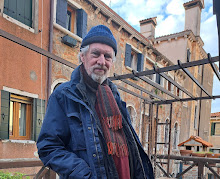Popular festivals – a preview of content from the forthcoming “House Magic” journal #5.
Big, popular short-term cultural events – festivals – have long been a principal cultural product of the 1970s occcupations. Call it convergence, rendezvous, or festival, these periodic celebrations play key roles in the life of land occupiers, reigniting the excitement and affirming the solidarities of the initial occupation, and the camaraderie of encampment. (See the story of the Amsterdam Balloon Factory of the Dutch free community of Ruigoord in House Magic #4, “Aja Waalwijk on TAZ.”)
The nomadic festivals of the Rainbow Family in the U.S. began in 1968 with a “be-in” in San Francisco's Golden Gate Park. The “gatherings” continue to this day on U.S. government park land, a demotic shadow of the upscale Burning Man festivals in the Nevada desert. Governments in the U.S. have never stopped trying to put the lid on these festivals, however.
Michael Niman, author of “People of the Rainbow: A Nomadic Utopia,” maintains a website of numerous documents relating to the group's struggles with government agencies managing the lands they encamp
http://buffalostate.edu/peopleoftherainbow/
Ryan Neeley, “The Government's Secret War on Music Festivals” details the trials of Jimmy Tebeau, musician in a Grateful Dead tribute band called The Schwag, who has held numerous festivals on his privately owned land; ownership does not protect these festivals from government harassment
http://www.gratefulweb.com/articles/governments-secret-war-music-festivals
The 1970s counterculture festival tradition continiues in the periodic events organized by urban “art squatters” in Europe. A number of them were held this year.
A Flop, with Beatings
In July, an Intersquat Festival was called for late July in Fribourg, Switzerland by a coalition of Swiss groups. The organizers, however, did not hide under cover of culture, but brandished their militancy. They chose to attempt a major occupation as the opening of the festival. Not surprisingly, it was violently suppressed. There were 52 arrests, accompanied by police “batoning anything that moved, including passers-by and people already on the ground, arresting people in cars and trains, in cafes, shopping” – arrestees were swabbed for DNA. It became an exhibition of police violence and a celebration of activist masochism.
call-out for the Fribourg Intersquat Festival
http://fr.squat.net/2012/07/12/suisse-festival-intersquat-27-07-5-08-et-jusqua-la-fin-du-capitalisme-et-de-son-monde/
event report of the brutal repression
http://www.indymedia.org.uk/en/2012/08/498939.html
Cops join the party during a demonstration of students in Torino, Italy // from World Riots (students' faces are blurred in the photo, not masked)
Emigration, Secession, Mass Shovel-In
Festival lies behind the recent strategies of the Dutch Damoclash group, working with the cultural squatters of Schijnheilig. They use the form to make very specific political points. In August of 2011, 50 Dutch artists and activists traveled from Amsterdam to Prishtina, Kosovo. “The Dutch budget cuts and severe police brutality towards squatters and cultural activists in The Netherlands is pushing artists into exile. Therefore we're seeking asylum in Kosovo.” In July they opened a temporary embassy of the “new Damoclash free state” in the Vondelpark of Amsterdam to prepare the trip.
In September of 2012, the Dutch squatters staged Damoclash, a one-day festival. “Damoclash is a recurring free and chaotic, culturally and non-commercial festival that merges protest art, politics and debate into a fun event.” The target of the temporary occupation was a patch of unbuilt land at Oostpoort, Amsterdam, where a publicly funded development was planned, the kind of mega-project they see as “very risky.”
Under the theme of “Gentrify It Yourself!,” they called people to “Take a shovel in hand, come to Damoclash and become one of our Cultural Partners (OCP). Show that you want to help build the city of Amsterdam. Come in your builders clothing, safety helmet, lights, battery drill.”
Who are the Damoclash?
http://nl.wikipedia.org/wiki/Damoclash
Damoclash: 2011 trip to Kosovo
http://ourmediaindymedia.blogspot.com.es/2011/07/damoclash-moves-to-kosovodan-ni3t-13.html
Damoclash call-out for 2012
http://schijnheilig.org/2012/09/2909-damoclash/
Charter of Occupation
Festival was also themed politically for three days this September with the Festiv' Aligre, produced by the “Free Commune of Aligre” in Paris. This sudden government was declared by the organizers after local officials denied them a license. The demand was familiar – public participation in the planning decisions that would affect the community. But this faux government first declared themselves “guardians of public disorder” for a period of festival, evoking the oldest traditions of European carnival. Street food, music concerts (all types), story-telling, dance (“garbage ballet”), cycling activities by the collective Vélorution – all are artfully described and intermingled with discussions on “this famous question, how to occupy public space.” These discussions were purposive: to frame a “charter” on how to manifest public space to be “hailed” as the school year starts. Naturally, the project is supported by numerous collectives, the town hall, city and state cultural ministries, and, significantly, the Fondation Abbé Pierre, named for the renowned French squatter priest, and local tenants' groups.
Festiv' Aligre
http://www.cl-aligre.org/spip/spip.php?article243
Abbé Pierre
http://en.wikipedia.org/wiki/Abb%C3%A9_Pierre
Next: Classic Art Squats
Sunday, October 21, 2012
Subscribe to:
Post Comments (Atom)


No comments:
Post a Comment
Note: Only a member of this blog may post a comment.